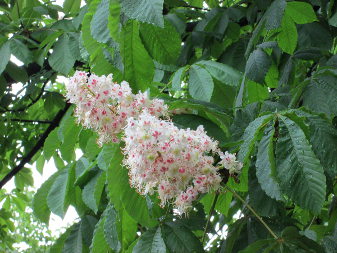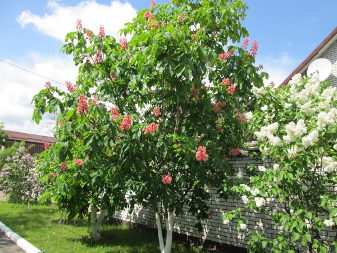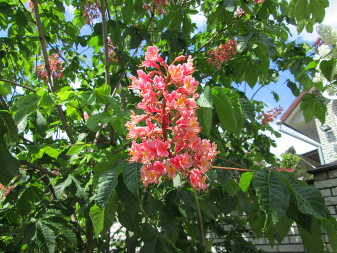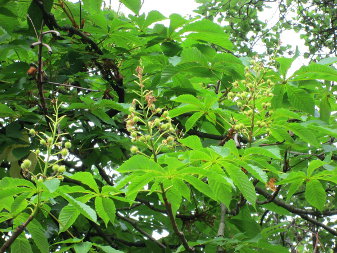













European Horse-chestnut (Aesculus hippocastanum), fam. Aesculaceae.
The flowers of the common form evolutionize from white with a yellow spot, which have no smell but are capable of pollination by the insects, to white with a red spot, with aroma, but already pollinated. In Kyiv, the red variety is also grown, but in DVRZ suburb only one such tree has been admitted in Volhovska street.
Horse-chestnut has nothing common with the edible chestnut, which also exists in Kyiv, but only in botanical gardens (where it even bears fruit, despite the ultimately cold climate – usually the edible chestnut grows massively in Western and Southern Europe). Our Horse-chestnut has quite hard, bitter fruits (a warning for those who are not stopped by bitterness: they are slightly toxic). Sometimes, the fruits are used as medicinal, but the universally accepted is medicinal use of the flowers. The tincture from the flowers decreases capillary permeability, stimulates the antotrombotic activity of blood serum, promotes blood viscosity reduction, increases veins tone.
Approximately from 2003, the prosperous life of horse-chestnuts, the symbols of Kyiv, subjected to a serious threat. It is the so-called horse-chestnut leaf miner, Cameraria ohridella, which has spread over all the Europe from the Balkans during thirty years, and before the 1980-s the science did not even know about its existence. The activity of the pest reveals as formation of yellow or brown spots on the leaves, which in severe cases mergr and cause complete defoliation by the middle or late summer. Often the trees make attempt to grow new shoots, and even to flower in September. While the total death of the trees is rare, their ornamental properties drop to zero. Unfortunately, there are quite few horse-chestnuts left in the city, about 10%, that are absolutely free from the moth. Among the defense measures we could name: replacement of the trees by resistant varieties; treatment with pesticides; spreading the natural parasites and predators; using the traps that attract the mothes by special smells; cleaning the fallen leaves and their removal to the places where the horse-chestnuts don't grow, or utilization by other methods. However, since the practical use of horse-chestnuts is limited, none of these quite costly methods has not seriously taken root yet.